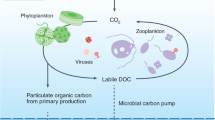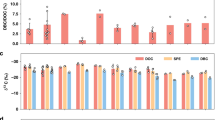Abstract
OCEANS contain a large absolute amount of organic material in solution. The origin, fate and involvement in biogeochemical processes of this large, but extremely dilute, pool of organic compounds is an enigma to those studying the life and chemistry of the oceans. Recent studies by several workers1–7 have shown that the dissolved organic carbon (DOC) content of deep water is relatively constant over a wide range of depths and throughout many regions of the world's oceans. The DOC content averages about 0.60 mg/l. and does not decrease significantly with depth from 400 m to 6,000 m (refs. 2 and 4), nor does the DOC increase in deep waters below highly productive regions such as along the coast of Peru2,4. The range of reported values is from 0.40 to 0.70 mg/l.
This is a preview of subscription content, access via your institution
Access options
Subscribe to this journal
Receive 51 print issues and online access
$199.00 per year
only $3.90 per issue
Buy this article
- Purchase on Springer Link
- Instant access to full article PDF
Prices may be subject to local taxes which are calculated during checkout
Similar content being viewed by others
References
Menzel, D. W., Deep-Sea Res., 11, 757 (1964).
Menzel, D. W., Deep-Sea Res., 14, 228 (1967).
Menzel, D. W., and Ryther, J. H., Deep-Sea Res., 15, 327 (1968).
Barber, R. T., thesis, Stanford Univ., 132 (1967).
Williams, P. W., Nature, 219, 152 (1968).
Ogura, N., and Hanya, T., J. Oceanol. Limnol., 1, 91 (1967).
Holm-Hansen, O., Strickland, J. D. H., and Williams, P. M., Limnol. Oceanogr., 11, 545 (1966).
Menzel, D. W., and Vaccaro, R. F., Limnol. Oceanogr., 9, 138 (1964).
Armstrong, F. A. J., Williams, P. W., and Strickland, J. D. H., Nature, 211, 479 (1966).
Skopinstev, B. A., Acad. Sci. USSR, Trans. Mar. Hydrophys. Inst., 19, 1 (1960).
Skopinstev, B. A., Oceanology, 6, 361 (1966).
Skopinstev, B. A., Abs. Second Intern. Oceanogr. Congr., 340 (1966).
Vaccaro, R. F., and Jannasch, H. W., Limnol. Oceanogr., 11, 596 (1966).
Duarsma, E. K., Neth. J. Sea Res., 2, 85 (1961).
Jannasch, H. W., J. Gen. Microbiol., 18, 609 (1958).
Jannasch, H. W., Limnol. Oceanog., 12, 264 (1967).
Jannasch, H. W., in Organic Matter in Natural Waters (in the press).
Author information
Authors and Affiliations
Rights and permissions
About this article
Cite this article
BARBER, R. Dissolved Organic Carbon from Deep Waters resists Microbial Oxidation. Nature 220, 274–275 (1968). https://doi.org/10.1038/220274a0
Received:
Issue Date:
DOI: https://doi.org/10.1038/220274a0
This article is cited by
-
Extensive primary production promoted the recovery of the Ediacaran Shuram excursion
Nature Communications (2022)
-
Enigmatic persistence of dissolved organic matter in the ocean
Nature Reviews Earth & Environment (2021)
-
Removal of Refractory Dissolved Organic Carbon in the Amundsen Sea, Antarctica
Scientific Reports (2020)
-
Distribution, degradation and bioavailability of dissolved organic matter in the East China Sea
Biogeochemistry (2019)
-
Mixing it up in the ocean carbon cycle and the removal of refractory dissolved organic carbon
Scientific Reports (2018)
Comments
By submitting a comment you agree to abide by our Terms and Community Guidelines. If you find something abusive or that does not comply with our terms or guidelines please flag it as inappropriate.



